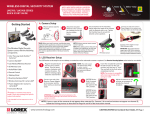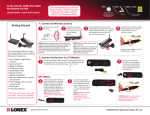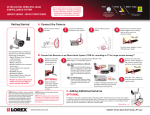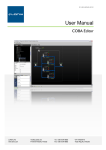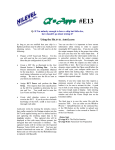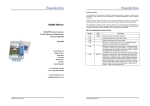Download Airfonix AFX-19PR001 User manual
Transcript
Step C ! Connect Equipment IMPORTANT: To avoid physical injury or damage to your equipment, we recommend you disconnect the units from the DC power adaptors and all components from their power sources until you complete the connections. Connecting the Receivers You may use up to two Airfonix R Series wireless receivers with each T Series transmitter. This is useful when the speakers are spaced far apart. To view examples diagrams for the six installation scenarios look in the User Manual. Make sure to set the correct zone codes for your installation. AFX-19AR050: Designed for use with semi-pro or home audio equipment. Use speaker cables to connect either two passive speakers at 25W per channel or one passive speaker at 50W per channel with banana plug connectors. AFX-19PR001: Designed for use with professional active speakers. Connect using XLR audio cables or RCA stereo audio jacks. ! IMPORTANT: • When using model AFX-19AR050 and connecting one receiver to one speaker the output will be 50W per channel. When connecting both speakers it will be 25W per channel. • When using model AFX-19PR001, to prevent signals mixing together, do not connect source to both the AUX L and R RCA jacks and the BALANCE IN sockets simultaneously. • The system will accommodate 4 to 8 ohms output. Any system with 70V will not work with these products. Connecting the Transmitter Airfonix T Series wireless transmitters may be connected to any audio product with a speaker output connection such as stereo receivers, digital TVs, DVD players, CD players, professional mixing consoles, gaming products, computers, iPods or MP3 players. AFX-19PT002: Designed for use with professional audio equipment. Connect using XLR audio cables into Balance In, optical cable into digital SPDIF input jack or RCA stereo cable into RCA jacks. AFX-19PT102: Designed for use with semi-pro or home audio equipment. Connect using speaker cables into HiLevel IN push terminals, RCA stereo cable into RCA jacks or optical cable into digital SPDIF input jack. ! ! IMPORTANT: • When using model AFX-19PT002, to prevent signals mixing together, do not connect source to both the AUX L and R RCA jacks and the BALANCE IN sockets simultaneously. • When using model AFX-19PT102, to prevent signals mixing together, do not connect source to both the AUX L and R RCA jacks and the HI-LEVEL IN sockets simultaneously. • When connecting an audio source using the SPDIF input, it must use either 44.1KHz or 48KHz sampling rates. Check the owner’s manual for your audio source if you are unsure. • Use supplied optical cable to connect HDTV to SPDIF input jack. IMPORTANT: Your system will not work properly unless the dip switches on each unit are set to the correct positions for your installation. • If the LINK LEDs light green, double check the Zone Codes. • If the LINK LEDs are not lit, go through the steps to Pair Units again. • Look in the User Manual for Troubleshooting Guide, or contact Customer Service at (888) 778-2446 or www.airfonix.com if you are having problems. Technical Support and additional information Please visit www.airfonix.com for: • Information and help with troubleshooting and support issues. • To contact customer service. • United States customers may contact customer service at (888) 778-2446. For other countries, visit www. airfonix.com to find the correct telephone number for your country. • For the latest product documentation, as well as the Airfonix License Agreement and Limited Warranty. Copyright © 2008, Airfonix. All rights reserved. Quick Start Guide Go to www.airfonix.com to view the User Manual. Airfonix R Series Wireless Receiver Models: AFX-19AR050 AFX-19PR001 Airfonix T Series Wireless Transmitter Models: AFX-19PT002 AFX-19PT102 Step A Pair Units Step B Set Zone Codes Step C Connect Equipment Step A ! Pair Units IMPORTANT: Before you begin, follow the sequence of six steps to PAIR each of the receivers with the transmitter in your installation. You may pair one transmitter with up to two receivers. You will need the remote control and a small screwdriver for these steps. Step 1 Step 2 Receiver(s) Transmitter Setting OFF Transmitter Setting OFF Receiver(s) DC IN DC IN Setting 9V OFF ON Setting 9V OFF ON ON ON For transmitter: All dip switches must be in OFF position. For all receivers: Push the third dip switch to ON position to enter pairing mode. Step 3 Connect the power for all units. Step 4 Receiver(s) Receiver(s) R PW lights orange. Transmitter R PW K LIN Press PAIRING LIN lights green PWR LED R Press PWR twice PWR LED PW Transmitter K K LIN K Pow Vol - Sou rce er Vol + Pai ring Mu te LIN Receivers are in pairing mode. PWR LED lights orange. Press the PWR button on transmitter to power ON. ! IMPORTANT: Complete steps 3 and 4 within 10 seconds. Watch the LINK LEDs to make sure the pairing is successful. Step 5 With the remote pointing at the transmitter, press the PAIRING button. Watch the LINK LEDs. • The transmitter LINK LED flashes for three seconds and then turns OFF. • The receiver(s) LINK LED light for one second and then turn OFF. Step 6 Transmitter Receiver(s) Setting OFF Setting OFF ON ON For transmitter: All dip switches must be in OFF position. For all receivers: Push the third dip switch to OFF position to exit pairing mode. The ID code has now been copied to each of the units and they are paired together. Follow the instructions for Set Zone Codes to complete setup. NOTE: The LINK LEDs on all paired units will light green AFTER you have set the zone codes and all units are powered ON again. Step B Set Zone Codes The Airfonix R and T Series are highly versatile. You may use one use one transmitter with up to two receivers in six scenarios. For examples, visit www.airfonix.com to view the user manual. First go through the bulleted list to determine if you are using: • • One or Two Receivers. Active or Passive Speakers. NOTE: Follow the black heading for passive and the blue heading for active speakers on the chart below. One or Two Zones. Power of Each Connected Speaker. NOTE: Scenarios 1 through 3 use different codes for setup with 4 ohm or 8 ohm speakers. LEFT or RIGHT Mono, or Stereo Channels. • • • Use the charts below to determine the correct settings for each unit: 1 Transmitter/1 Receiver 1 ZONE 1 Transmitter/2 Receivers 1 ZONE Scenario 1 (4 ohm) Transmitter Receiver Stereo Scenario 2 (4 ohm) Transmitter 4 ohm, 25W/ch Receiver Receiver Mono LEFT Mono RIGHT 4 ohm, 50W 4 ohm, 50W 1 Transmitter/2 Receivers 2 ZONES Scenario 3 (4 ohm) Transmitter Receiver Receiver Stereo Stereo 4 ohm, 25W/ch 4 ohm, 25W/ch Setting OFF Setting OFF Setting OFF Setting OFF Setting OFF Setting OFF Setting OFF Setting OFF ON ON ON ON ON ON ON ON 1 Transmitter/1 Receiver 1 ZONE 1 Transmitter/2 Receivers 1 ZONE Scenario 1 (8 ohm) Transmitter Receiver Stereo 8 ohm, 25W/ch Scenario 2 (8 ohm) Transmitter Receiver Receiver mono LEFT mono RIGHT 8 ohm, 36W 8 ohm, 36W 1 Transmitter/2 Receivers 2 ZONES Scenario 3 (8 ohm) Transmitter Receiver Receiver Stereo Stereo 8 ohm, 25W/ch 8 ohm, 25W/ch Setting OFF Setting OFF Setting OFF Setting OFF Setting OFF Setting OFF Setting OFF Setting OFF ON ON ON ON ON ON ON ON 1 Transmitter/1 Receiver 1 ZONE 1 Transmitter/2 Receivers 1 ZONE Scenario 4 Transmitter Scenario 5 Receiver Stereo Active Speakers Transmitter Receiver Receiver Mono LEFT Mono RIGHT Active Speakers Active Speakers Setting OFF Setting OFF Setting OFF Setting OFF ON ON ON ON 1 Transmitter/2 Receivers 2 ZONES Scenario 6 Transmitter Receiver Stereo Active Speakers Receiver Stereo Active Speakers Setting OFF Setting OFF Setting OFF Setting OFF ON ON ON ON Use a small screwdriver to set the correct codes for each unit: Disconnect the power from all units. Locate the three dip switches on the bottom of each unit. Use a small flat screwdriver to push the first and second dip switches to ON or leave in OFF position to match the code for your installation. Setting OFF ON Setting OFF ON ! ! IMPORTANT: Do not adjust the third dip switch. Leave it in the OFF position after pairing. The factory default position is OFF for all switches. IMPORTANT: Pay close attention when making these connections. The receiver set with the left channel codes connects to your speaker using the left output connectors and the receiver set with the right channel codes connects to your speaker using the right output connectors. The system will not work unless these connections are correct.





